
Passiflora edulis, commonly known as passion fruit, is a vine species of passion flower native to southern Brazil and Peru. It is cultivated commercially in tropical and subtropical areas for its sweet, seedy fruit. The fruit is a pepo, a type of berry, round to oval, either yellow or dark purple at maturity, with a soft to firm, juicy interior filled with numerous seeds. The fruit is both eaten and juiced, with the juice often added to other fruit juices to enhance aroma.

Physalis is a genus of approximately 75 to 90 flowering plants in the nightshade family (Solanaceae), which are native to the Americas and Australasia. At least 46 species are endemic to Mexico. Cultivated and weedy species have been introduced worldwide. A defining feature of Physalis is a large, papery husk derived from the calyx, which partly or fully encloses the fruit. Many species bear edible fruit, and some species are cultivated.

The tamarillo is a small tree or shrub in the flowering plant family Solanaceae. It is best known as the species that bears the tamarillo, an egg-shaped edible fruit. It is also known as the tree tomato, tomate de árbol, tomate andino, tomate serrano, blood fruit, poor man's tomatoe, tomate de yuca, tomate de españa, sachatomate, berenjena, chilto and tamamoro in South America, tyamtar, rambheda or rukh tamatar in Nepal, and terong Belanda in Indonesia. It is popular globally, especially in Peru, Colombia, New Zealand, Ecuador, Nepal, Rwanda, Burundi, Australia, Bhutan and the United States.
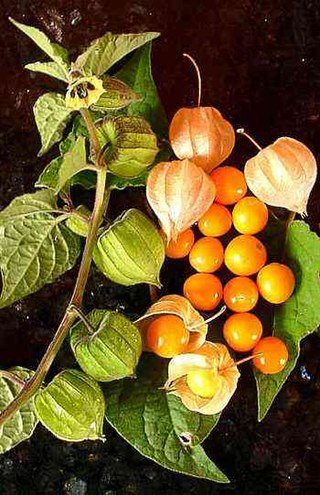
Physalis peruviana is a species of plant in the nightshade family (Solanaceae) native to Chile and Peru. Within that region, it is called aguaymanto, uvilla or uchuva, in addition to numerous indigenous and regional names. In English, its common names include Cape gooseberry, goldenberry and Peruvian groundcherry.
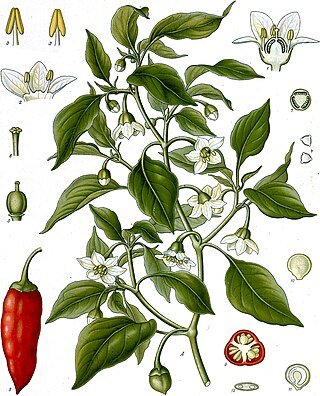
Capsicum annuum is a fruiting plant from the family Solanaceae (nightshades), within the genus Capsicum which is native to the northern regions of South America and to southwestern North America. The plant produces berries of many colors including red, green, and yellow, often with pungent taste. It also has many varieties and common names including paprika, chili pepper, jalapeño, cayenne, bell pepper, and many more with over 200 variations within the species. It is also one of the oldest cultivated crops, with domestication dating back to around 6,000 years ago in regions of Mexico. The genus Capsicum has over 30 species but Capsicum annuum is the primary species in its genus, as it has been widely cultivated for human consumption for a substantial amount of time and has spread across the world. This species has many uses in culinary applications, medicine, self defense, and can even be ornamental.

Physalis angulata is an erect herbaceous annual plant belonging to the nightshade family Solanaceae. Its leaves are dark green and roughly oval, often with tooth shapes around the edge. The flowers are five-sided and pale yellow; the yellow-orange fruits are borne inside a balloon-like calyx. The exact native range is uncertain. The species may be naturally endemic to Australia or the Americas or the native range may encompass both the Americas and Australia. It is now widely distributed and naturalized in tropical and subtropical regions worldwide.

Solanum muricatum is a species of evergreen shrub native to South America and grown for its sweet edible fruit.
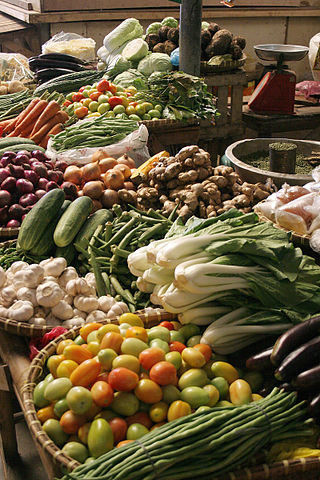
Vegetables are parts of plants that are consumed by humans or other animals as food. The original meaning is still commonly used and is applied to plants collectively to refer to all edible plant matter, including the flowers, fruits, stems, leaves, roots, and seeds. An alternative definition of the term is applied somewhat arbitrarily, often by culinary and cultural tradition. It may exclude foods derived from some plants that are fruits, flowers, nuts, and cereal grains, but include savoury fruits such as tomatoes and courgettes, flowers such as broccoli, and seeds such as pulses.

The tomato is the edible berry of the plant Solanum lycopersicum, commonly known as the tomato plant. The species originated in western South America, Mexico, and Central America. The Nahuatl word tomatl gave rise to the Spanish word tomate, from which the English word tomato derives. Its domestication and use as a cultivated food may have originated with the indigenous peoples of Mexico. The Aztecs used tomatoes in their cooking at the time of the Spanish conquest of the Aztec Empire, and after the Spanish encountered the tomato for the first time after their contact with the Aztecs, they brought the plant to Europe, in a widespread transfer of plants known as the Columbian exchange. From there, the tomato was introduced to other parts of the European-colonized world during the 16th century.
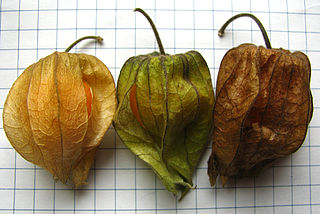
Physalis heterophylla, colloquial name clammy groundcherry, is species of herbaceous plant in the family Solanaceae. It is native to North America, occurring primarily in the eastern United States and Canada. It is known to occur in all contiguous states except for Nevada and California. It is found mainly in habitats such as dry or mesic prairies, gravel hills and rises, sandy or rocky soils, and waste places such as roadsides.

Physalis longifolia, known by the common names common groundcherry, longleaf groundcherry, and wild tomatillo, is a species of flowering plant in the nightshade family, Solanaceae. It is native to North America, where it is native to eastern Canada, much of the continental United States, and northern Mexico. It has also been noted as an introduced species in other regions, including parts of the United States outside its native range. In some areas, such as California, it is an occasional noxious weed.
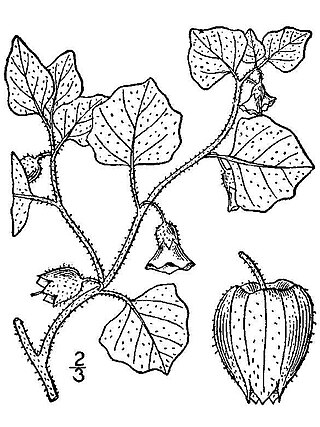
Physalis pubescens is a species of flowering plant in the nightshade family known by many common names, including husk tomato, low ground-cherry and hairy groundcherry in English, and muyaca and capulí in Spanish. It is native from Brazil, but also found in southern half of the United States, Mexico, Central and much of South America. It can be found elsewhere as an introduced species and sometimes a weed. It can grow in many types of habitat, including disturbed areas. This is an annual herb producing a glandular, densely hairy stem up to about 60 cm (24 in) in maximum height from a taproot. The oval or heart-shaped leaves are 3–9 cm (1.2–3.5 in) long and have smooth or toothed edges. The flowers blooming from the leaf axils are bell-shaped and about a centimeter long. They are yellow with five dark spots in the throats, and have five stamens tipped with blue anthers. The five-lobed calyx of sepals at the base of the flower enlarges as the fruit develops, becoming an inflated, ribbed, lanternlike structure 2–4 cm (0.79–1.57 in) long which contains the berry.
Solanum vestissimum is a subtropical perennial plant from northwestern South America. Also known within its native range as toronjo, tumo, or coquina melón, S. vestissimum is a large semi-woody plant or shrub, up to 8 meters in height, though usually much smaller. The very large heart-shaped leaves are lined with spines along the top and bottom of the dorsal vein, similar to the naranjilla or pseudolulo. The leaves and stems of the plant are otherwise covered in short, felt-like hairs.

Solanum diphyllum, commonly known as the twoleaf nightshade, is a species of nightshade native to the Americas. It is cultivated as an ornamental plant for its clusters of dark green round fruits that turn a bright yellow when ripe.

The Celebrity tomato cultivar is a hybrid (biology) that produces long fruit-bearing stems holding 20 or more very plump, robust tomatoes. Fruits weigh approximately 8 oz., and are 4 inches across. Plants need caging or staking, and produce fruit throughout the growing season. The celebrity tomato is a cultivar of the species Solanum lycopersicum. It is a crossbreed of the common tomato that is widely used for various culinary purposes. This tomato is of great size and is known to be resistant to most tomato diseases such as Fusarium wilt, Verticillium wilt, Tobacco mosaic virus and Root-knot nematode due to its hybrid nature. Celebrity tomatoes are highly adaptive to harsh environments and can grow in a wide range of places including dry, humid and wet regions. They are resistant to cracking and splitting which usually occurs when there is an excess of water and sugar movement in the fruits. Therefore, causing the tomato skin to grow at a slower rate compared to the expansion of the fruit. They can survive in harsh uneven rainfall. However, they are highly susceptible to colder environments and are at a higher risk of dying in regions with short growing seasons. The plants can grow up to 5 feet in height with bright red medium-sized fruits. The plants are generally very thick and grow in clusters. The tomato fruits are mostly used in the making of various salsas, salads, juices and canned food.

Physalis virginiana, the Virginia groundcherry, is a rhizomatous perennial with a deeply buried stem base. It is found mostly in eastern North America as far west as Wyoming.
Physalis caudella, the southwestern groundcherry or tomatillo chiquito, is a plant in the family Solanaceae, native to Arizona, Sonora and Chihuahua. The purple-green fruits are small but edible.

The Solanaceae, or the nightshades, are a family of flowering plants that ranges from annual and perennial herbs to vines, lianas, epiphytes, shrubs, and trees, and includes a number of agricultural crops, medicinal plants, spices, weeds, and ornamentals. Many members of the family contain potent alkaloids, and some are highly toxic, but many—including tomatoes, potatoes, eggplant, bell and chili peppers—are used as food. The family belongs to the order Solanales, in the asterid group and class Magnoliopsida (dicotyledons). The Solanaceae consists of about 98 genera and some 2,700 species, with a great diversity of habitats, morphology and ecology.

Lema daturaphila, commonly known as the three-lined potato beetle, is a species of beetle in the family Chrysomelidae. It is originally from Central and North America, but has spread elsewhere.

Physalis pruinosa is a plant in the genus Physalis in the nightshade family Solanaceae, often referred to as ground cherry or husk tomato. It is a native species in a range extending from northern Mexico through Central America. The plant has a low, spreading habit, and fruits develop in a papery husk, as is characteristic of the genus. While most parts of the plant are toxic to humans due to the presence of solanine and solanidine, the fruit becomes edible once it has ripened to yellow. The fruit's flavor is similar in some respects to that of a ripe tomatillo, but notably has a strong flavor of pineapple as well, a fact reflected in the name of a common commercial variety, "Cossack Pineapple". The ripe fruit of Physalis pruinosa var. argentinaJ. M. Toledo & Barboza is a food source for the Pilagá ethnic group.




























